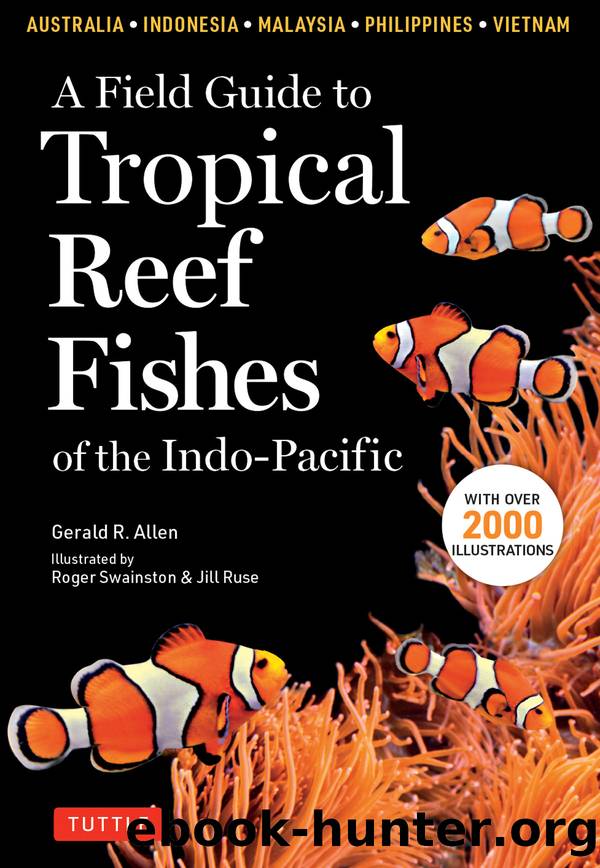A Field Guide to Tropical Reef Fishes of the Indo-Pacific by Gerald R. Allen

Author:Gerald R. Allen [Allen, Gerald R.]
Language: eng
Format: epub
Published: 0101-01-01T00:00:00+00:00
PLATE 80: WRASSES
LABRIDAE
1. SURGE WRASSE
Thalassoma purpureum (Forsskål, 1775)
Inhabits rocky reefs and inshore coral reefs, usually where there is wave action; male distinguished by ornate pattern highlighted by reddish-pink to purple stripes, female and juvenile greenish with double row of elongate red to brown blotches or stripes on middle and lower side; also known as Red-and-Green Wrasse; Great Barrier Reef, N.W. Australia and throughout S.E. Asia; Indo-C. Pacific; to 40 cm.
2. BLUEHEAD WRASSE
Thalassoma amblycephalum (Bleeker, 1856)
Inhabits coral and rocky reefs, usually several females seen with each male; male distinguished by bluish head with broad pale band just behind head, female has dark stripe or is overall brownish on upper half of body and white below; Great Barrier Reef, N.W. Australia and throughout S.E. Asia; Indo-W. Pacific; to 15 cm.
3. SEVENBAND WRASSE
Thalassoma septemfasciatum Scott, 1959
Inhabits rocky and weedy reefs; male distinguished by uniform dark body and yellow pectoral fins, female by broad greenish bars on side and yellow colour on pectoral fin base; W.Australia only, between Rottnest Island and Coral Bay; to 31 cm.
4. MOON WRASSE
Thalassoma lunare (Linnaeus, 1758)
Inhabits coral and rocky reefs; distinguished from T. lutescens (5) by magenta central portion of pectoral fin; juveniles (not shown) have a bluish belly and large black spot at base of tail; Great Barrier Reef, N.W. Australia and throughout S.E. Asia; Indo-W. Pacific; to 30 cm.
5. GREEN MOON WRASSE
Thalassoma lutescens (Lay & Bennett, 1839)
Inhabits coral and rocky reefs; male similar to T. lunare (4), but with blue-edged pectoral fin and lighter body colour, juvenile (not shown) with black midlateral stripe; Great Barrier Reef, N.W. Australia and throughout S.E. Asia; Indo-C. Pacific; to 30 cm.
6. SIXBAR WRASSE
Thalassoma hardwicke (Bennett, 1830)
Inhabits coral reefs; distinguished from T. jansenii (7) by narrower bars, some of which extend to belly region; Great Barrier Reef, N.W. Australia and throughout S.E. Asia; Indo-C. Pacific; to 18 cm.
7. JANSENâS WRASSE
Thalassoma jansenii (Bleeker, 1856)
Inhabits coral reefs; similar to T. hardwicke (6), but has broader bars that do not extend onto belly; Great Barrier Reef, N.W. Australia and throughout S.E. Asia; Indo-W. Pacific; to 18 cm.
8. LONG GREEN WRASSE
Pseudojuloides elongatus Ayling & Russell, 1977
Inhabits weed beds; distinguished by elongate shape, male has orange blotch at pectoral base and blue spots on upper side, female uniform greenish; W. Australia (between Abrolhos Islands and Dampier Archipelago), New South Wales, New Zealand and Japan; to 15 cm.
9. BLUETOOTH TUSKFISH
Choerodon typus (Bleeker, 1857)
Inhabits flat sandy bottoms or rubble; distinguished by blue and yellow stripes in front of eye and yellowish fins; N.Australia (North West Shelf to Cape York) and throughout S.E. Asia to S. India; to 14 cm.
10. BLUE RAZORFISH
Iniistius pavo (Valenciennes, 1840)
Inhabits sand bottoms, uses keeled forehead to burrow into the sand when threatened; distinguished by broad brown bars and antenna-like first dorsal fin; Great Barrier Reef, N.W. Australia and throughout S.E. Asia; Indo-C. Pacific; to 35 cm.
11. LEAF WRASSE
Iniistius dea (Temminck & Schlegel, 1845)
Inhabits sand bottoms, burrows in sand when threatened; distinguished by antenna-like first dorsal fin, red or pinkish colour with vague bars and small
Download
This site does not store any files on its server. We only index and link to content provided by other sites. Please contact the content providers to delete copyright contents if any and email us, we'll remove relevant links or contents immediately.
Sapiens: A Brief History of Humankind by Yuval Noah Harari(13046)
The Tidewater Tales by John Barth(12028)
Do No Harm Stories of Life, Death and Brain Surgery by Henry Marsh(6335)
Mastermind: How to Think Like Sherlock Holmes by Maria Konnikova(6233)
The Thirst by Nesbo Jo(5783)
Why We Sleep: Unlocking the Power of Sleep and Dreams by Matthew Walker(5639)
Sapiens by Yuval Noah Harari(4534)
Life 3.0: Being Human in the Age of Artificial Intelligence by Tegmark Max(4501)
The Longevity Diet by Valter Longo(4445)
The Rules Do Not Apply by Ariel Levy(3904)
The Immortal Life of Henrietta Lacks by Rebecca Skloot(3824)
The Body: A Guide for Occupants by Bill Bryson(3797)
Why We Sleep by Matthew Walker(3770)
Animal Frequency by Melissa Alvarez(3752)
Yoga Anatomy by Kaminoff Leslie(3699)
Barron's AP Biology by Goldberg M.S. Deborah T(3630)
The Hacking of the American Mind by Robert H. Lustig(3579)
All Creatures Great and Small by James Herriot(3512)
Yoga Anatomy by Leslie Kaminoff & Amy Matthews(3394)
